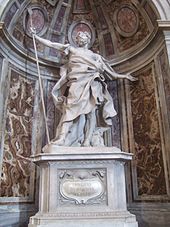Longinus

The holy Longinus was after the apocryphal Gospel of Nicodemus and after the Golden Legend that Roman centurion who Jesus after his death a spear (the " Holy Lance said to have") in the side pin and after the Gospel of Matthew and the Gospel of Mark , the divine sonship testified Jesus. The name day of St. Longinus is March 15th.
Baptism and martyrdom
The person who opened the page to Jesus after his passing was named in the Gospel of John ( Jn 19.34 EU ) as one of the hunters who broke the legs of the two men who were crucified next to Jesus (during the crurifragium ). Only apocryphal the soldier is named as Longinus and increasingly as a captain ( centurion called).
The veneration of the Holy Blood , which escaped from the wound uncompromised, found its way into cult during the 10th and 11th centuries and gained in importance with Francis of Assisi and the veneration of the stigmata in the 13th century. The wound fluid is said to have healed Longinus' eye disease, whereupon he collected the blood mixed with earth and was baptized. He left Palestine and preached the Gospel in Mantua , from where the worship of the Holy Blood began. To avoid persecution, he traveled to Caesarea in Cappadocia in what is now Turkey. Before leaving Mantua, he buried the blood of Christ. He is said to have been martyred in Caesarea. In this respect he would have been a martyr in two senses: in the New Testament sense as one of the first witnesses of the divinity of Christ and in the early Christian sense as a person who is killed for the confession of his faith.
The Holy Lance , which has belonged to the regal regalia of the Holy Roman Empire of the German Nation , the Imperial Regalia , since the early Middle Ages , was first mentioned in a papal letter from the first third of the 13th century with the Lance of Longinus, whose name probably derives from the "Long lance" was borrowed, identified. From the 14th century, this interpretation officially took hold.
Longinus in the iconography of the passion
In Christian iconography , Longinus and the sponge- bearer Stephaton often form a pair on either side of the cross.
A statue of Longinus, created by Gianlorenzo Bernini , is in a dome niche in St. Peter's Basilica .
In the folk art of the Black Forest, the carved Longinus cross found regional distribution.
See also
literature
- Ekkart Sauser : Longinus (Longinos). In: Biographisch-Bibliographisches Kirchenlexikon (BBKL). Volume 20, Bautz, Nordhausen 2002, ISBN 3-88309-091-3 , Sp. 943.
- Louis de Wohl : Longinus the witness (The Spear). Roman Walter, Olten 1955.
- J [ozef] van Haver: Longinus en de Longinuslegende in het Nederlandse taalgebied. In: Handelingen der Koninklijke Zuidnederlandse Maatschappij voor Taalend Letterkunde en Geschiedenis. Volume 17, 1963, pp. 397-459, and Volume 18, 1964, pp. 323-364.
- Wolf-Dieter Müller-Jahncke : Longinus blessing. In: Werner E. Gerabek , Bernhard D. Haage, Gundolf Keil , Wolfgang Wegner (eds.): Enzyklopädie Medizingeschichte. De Gruyter, Berlin / New York 2005, ISBN 3-11-015714-4 , p. 863.
- Longinus Centurio . In: Johann E. Stadler , Franz Joseph Heim, Johann N. Ginal (eds.): Complete Lexicon of Saints ... , Volume 3 ([I] K – L), B. Schmid'sche Verlagbuchhandlung (A. Manz ), Augsburg 1869, pp. 855-861 .
Web links
Individual evidence
- ↑ Jacobus a Voragine: Legenda aurea . Ed .: Th. Graesse. Otto Zeller, Osnabrück 1969, p. 202 .
- ↑ John 19:34 EU
- ↑ Mt 27.54 EU , Mark 15.39 EU
- ↑ Das Römische Martyrologium - Das Heiligengedenkbuch der Catholic Church , Verlag Friedrich Pustet , Regensburg 1935, 2nd edition, p. 63.
- ^ Anton Hungari (ed.): Osterglöcklein. Uplifting conversations for the Easter festival group in the Catholic church years. J. D. Sauerländer, Frankfurt am Main 1862, p. 78 f. ( The holy lance ).
| personal data | |
|---|---|
| SURNAME | Longinus |
| BRIEF DESCRIPTION | Roman centurion who is said to have stabbed a spear in Jesus' side after his death |
| DATE OF BIRTH | 1st century BC BC or 1st century |
| DATE OF DEATH | 1st century |
